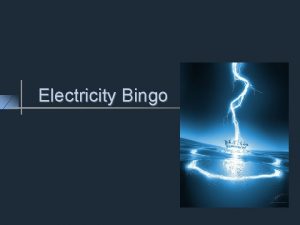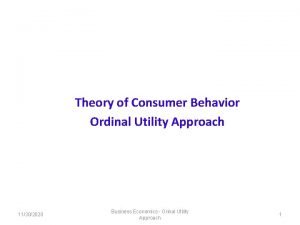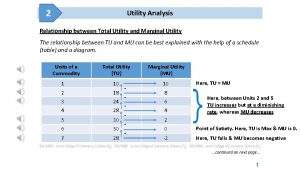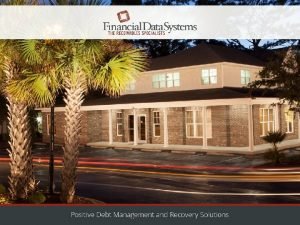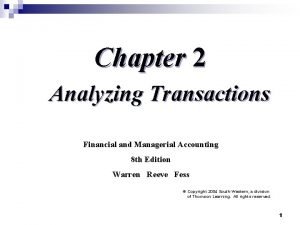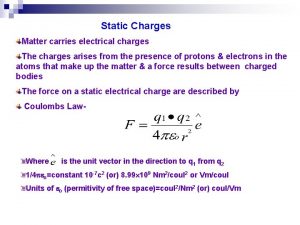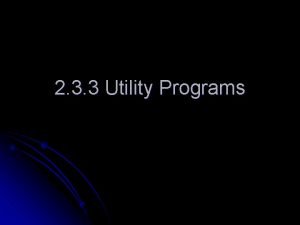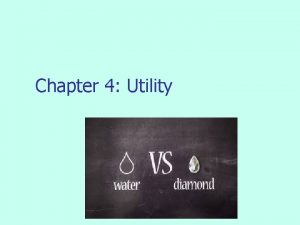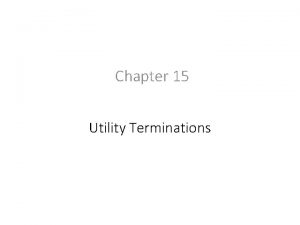Customer Charges UTILITY FINANCIAL SOLUTIONS LLC 2 Customer












- Slides: 12

Customer Charges UTILITY FINANCIAL SOLUTIONS, LLC

2 Customer Charges RPU An embedded cost of service study uses current and projected expenses and past investments in infrastructure to determine the cost of providing service to customers Once costs are identified they are classified into three components Demand-related Energy-related Customer-related

3 Cost Causation Demand-related costs are allocated to customers based on the classes contribution toward system peaks and/or infrastructure provided to meet the customers demands. For residential customers this is recovered through the energy component of the rate Energy-related costs are allocated based on the energy needed to provide service to each class of customers Customer-related costs are allocated to each class based on cost to maintain service at zero usage

4 Factors in Rate Designs Cost of service results are a significant component in a rate design to help ensure fairness to customers Other factors are sometimes considered to achieve community objectives. Please note that rates based on these factors may cause deviations from cost of service based rates creating cross-customer/class subsidies Marginal Costs – The cost to service the next k. Wh of electricity or k. W of demand Environmental factors – such as promotion of energy efficiency or renewable energy Social Considerations – Impacts on low income customers RPU’s practice, based on the City Charter and the RPU Board Policy, has been to set rates based on cost of service concepts to reduce cross-subsidization between rate payers.

Customer Charges Cost Component Recovery Recovers cost for connection to Grid at zero k. Wh consumption • • • Meter operation, maintenance and replacement costs Meter reading costs or AMR installation costs Billing Costs Customer Service Department Service into customers facilities Portion of Distribution System • Cost to get a wire from the sub-transmission system to customer • Based on minimum sizing (If all customers only used a single k. Wh)

Image Source: http: //image. slidesharecdn. com/sahir-120725071626 -phpapp 01/95/power-system-in-pakistan-2 -728. jpg? cb=1343201139

Percent of Distribution Cost to Residential Customer Charge UFS uses a standard industry approach of minimum system analysis to identify the portion of the distribution system to include in the customer charges UFS reviewed a number of cost of service studies completed in the past year to identify the percentage of distribution costs allocated to the customer charges. Example total costs allocated to customer charge divided by total distribution related costs. RPU 61%; survey average 54% RPU residential full cost of service customer charge is $21. 60/month, RPU’s current customer charge of $19. 50 is not recovering full cost; the survey average cost-based customer charge was $22. 66 Of the 12 similar utilities surveyed, RPU was the 9 th highest. Primarily due to factors discussed on upcoming slide 9 7

Percent Distribution Costs to Residential Customer Charges Compared to Other Utilities RPU is currently charging $19. 50 customer charge below cost of service charges 8

9 Factors Influencing Customer Charges Density of Service Territory Higher number of customers served by a mile of line will lower the customer charges Age of System – RPU is approximately 45% depreciated compared to national average of 50%. Newer system tends to increase customer charges System Design. To ensure system reliability RPU maintains standards including a redundant loop and additional feeder capacity capable of backing up other feeders if needed during emergencies Operation and Maintenance Costs

10 Minimum System Method The minimum system analysis is an industry accepted method to classify the customer-related and usage related components of the distribution system. The need for distribution infrastructure exists for a customer have access to electric service The minimum system approach obtains information from the engineering department on the number and current replacement cost of the distribution system.

11 RPU Cost of Service Study RPU’s cost of service study is consistent with Industry Standards and produces a reasonable residential customer charge Deviations from cost of service produces cost shifting between customers RPU’s cost-based customer charge is reasonable compared with similar utilities RPU’s has been moving toward cost-based customer charges for over 9 years. Many others have recently started the process. The industry movement is due to the effectiveness of energy efficiency programs, installation of roof top solar and prevention of cost shifting to other users

12 Residential Rate Design and Impacts Rate Design Customer Impacts
 Customer experience solutions llc
Customer experience solutions llc Utility financial solutions
Utility financial solutions Like charges blank and opposite charges blank
Like charges blank and opposite charges blank Ordinal utility and cardinal utility
Ordinal utility and cardinal utility Relation between marginal utility and total utility
Relation between marginal utility and total utility Reo management solutions llc
Reo management solutions llc Peridot solutions llc
Peridot solutions llc Trimed billing solutions
Trimed billing solutions Po box 688 wrightsville beach nc
Po box 688 wrightsville beach nc Sample of utilities expense
Sample of utilities expense Summary of ratio analysis
Summary of ratio analysis Dfs inc flex plan
Dfs inc flex plan Financial accounting chapter 2 solutions
Financial accounting chapter 2 solutions


